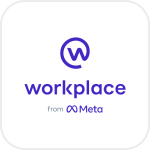
- Overview
- Configuration
Workplace from Meta
Enhance collaboration with ADManager Plus and Meta Workplace integration
Workplace from Meta is an all-in-one business collaboration tool developed by Meta. It helps teams enable real-time interactions, with features like text messaging, data sharing, and live video tools. Integrating ADManager Plus with Workplace from Meta enhances operational efficiency by automatically provisioning and deprovisioning user accounts in Workspace based on user data in Active Directory (AD) and vice versa. This automation reduces the administrative burden while eliminating manual errors. Consequently, organizations can maintain accurate user data and enhance productivity by focusing on strategic tasks rather than routine account management.
Effortlessly onboard new hires
ADManager Plus workflows help create seamless onboarding experience by provisioning user accounts across Active Directory (AD), Exchange, Microsoft365 and other applications when users are created in Workplace.
Automate offboarding efficiently
Upon an employee's departure, their user accounts can be deprovisioned based on changes in Workplace, ensuring a clean complete transition.
Need assistance to integrate "Workplace from Meta with ADManager Plus?
How to integrate ADManager Plus and Workplace from Meta
Prerequisites:
Please make sure to provide the bearer token to retrieve the desired information and perform tasks in Meta Workplace. Refer to Meta Workplace API references for more details.
Privileges:
- To import users (inbound actions): Ensure the account used for authorization has the permission to read all user accounts.
- To perform any action or query in Workplace (outbound actions): Ensure the account used for authorization has the permission to perform the desired action.
Authorization configuration
- Log in to ADManager Plus and navigate to the Automation tab.
- In the left pane, under Configuration, click Application Integrations.
- Under Enterprise Applications, click Workplace.
- Toggle the Enable Workplace Integration button on.
- In the Workplace Configuration page, click Authorization.
- From the Authorization Type drop-down, select Bearer.
- Perform the steps to generate Bearer token in Workplace and paste the Bearer token in the Value field.
- Click Configure.
Inbound webhook configuration
Inbound webhooks enable you to fetch user data from Workplace and send it to ADManager Plus. The attribute mapping configured in this section can be selected as the data source during automation configuration. perform the desired action on the list of users received from the API response.
To configure an inbound webhook for Workplace:
- Under Inbound Webhook, click Workplace Endpoint Configuration.
- In the Endpoint Configuration tab, an endpoint, Workplace USERS ENDPOINT comes preconfigured with the Endpoint URL, Method, Headers, and Parameters fields filled out to fetch user accounts from Workplace. If you would like to use this preconfigured endpoint, replace {company_id} with the domain name of your Workplace instance in the Endpoint URL field. However, if you would like to use a new endpoint to import users, you can configure one by clicking the + Add API Endpoint button and filling in the required fields according to Workplace's API references. Click here to learn how.
- The API key-value pair is preconfigured as a header for authenticating API requests as configured during Authorization Configuration.
- Macros: You can add macros to your endpoint configuration to dynamically change it as per your requirement using the macro chooser component.
- Refer to Workplace's API references to configure additional headers and parameters, if required.
- Once done, click Test & Save. A response window will display all the requested parameters that can be fetched using the API call. Click Proceed.
- Refer to Workplace's API references to know the parameters that must be configured to fetch only specific parameters.
- You can configure multiple endpoints for actiTIME using the + Add API endpoint button. Click here to learn how.
- Click Data Source - LDAP Attribute Mapping to match endpoints and to map AD LDAP attributes to the respective attributes in Workplace.
- Click + Add New Configuration
- Enter the Configuration Name and Description and select the Automation Category from the drop-down menu.
- In the Select Endpoint field, select the desired endpoint and a Primary Key that is unique to a user (e.g. employeeIdentifier). Note: When multiple endpoints are configured, this attribute must hold the same value in all the endpoints.
- In the Attribute Mapping field, select the attribute from the LDAP Attribute Name drop-down menu and map it to the respective attribute in Workplace.
- If you would like to create a new custom format for this, click Add New Format.
- Click Save.
Note:
Note:

